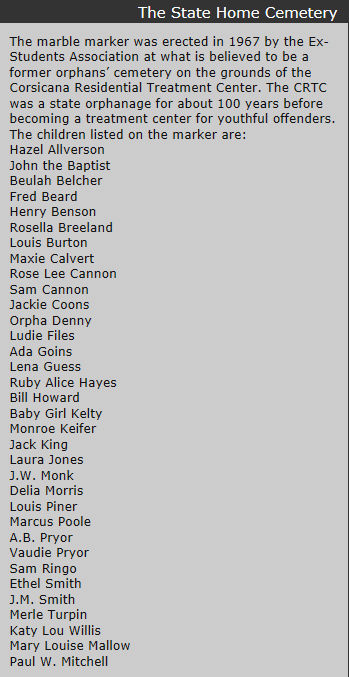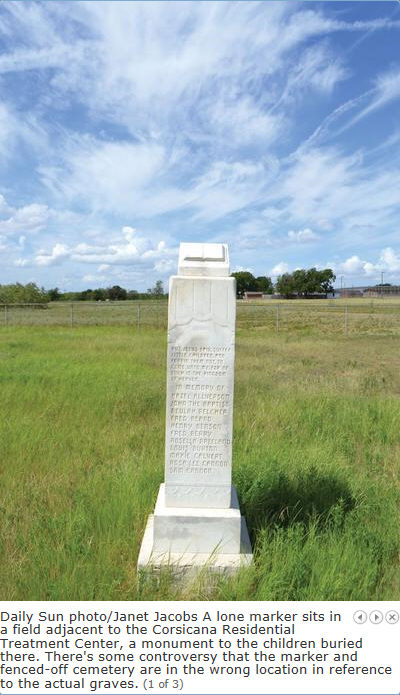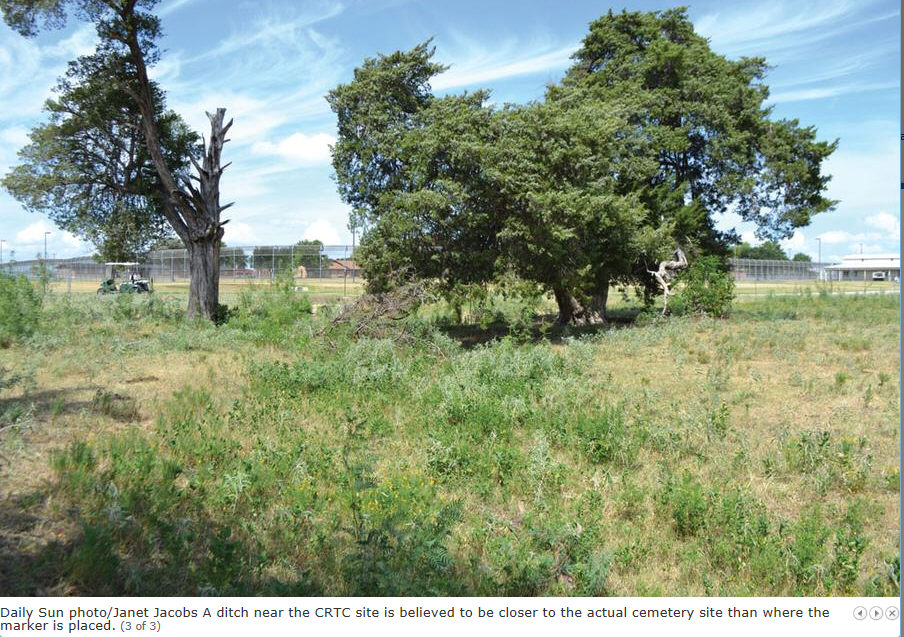August 24, 2013
By Janet Jacobs
Corsicana Daily Sun
- See more at: http://corsicanadailysun.com/local/x1253328987/State-Home-cemetery-history-recalled#sthash.YOz8KN9t.dpuf
August 24, 2013
By Janet Jacobs
Corsicana Daily Sun
- See more at: http://corsicanadailysun.com/local/x1253328987/State-Home-cemetery-history-recalled#sthash.YOz8KN9t.dpuf
State Home Cemetery History Recalled
By Janet Jacobs Corsicana Daily Sun
Corsicana Daily Sun - August 24, 2013
Corsicana — A single white marble marker stands in a fenced-in yard in the
middle of a pasture just south of the Corsicana Residential Treatment Center’s
main gates. It marks the graves of 35 children who died at the former orphanage.
What’s unclear is if it’s in the right place.
An article for the Corsicana Daily Sun, published Oct. 19, 2003, and written by
contributor Charles Wayne Johnson who lived at the State Home for 14 years,
claims the marker is probably 200 yards south of the actual cemetery site.
Johnson recounted that a previous superintendent plowed up the old cemetery in
the early 1960s, removing all the metal markers that denoted individual graves.
Lawrence DeMoss, who worked at the facility for 30 years starting Sept. 7, 1962,
doesn’t recall that incident.
“I don’t know anything about it being plowed under in the 1960s, unless it was
before my time,” he said. “I’m aware there was some talk or controversy that
maybe the site was moved at one time.”
An estimated 30 of the children buried on the site probably succumbed to
influenza in the world-wide epidemic that killed millions in 1918, according to
a former superintendent. Still, at least one or two died of other childhood
accidents and illnesses, according to former residents and employees of the
State Home.
“It could have been the flu in 1918, and a time or two of different types of
sicknesses in the early 1900s,” said Jesse Lowery, president of the ex-students
association. The association put up the carved marble obelisk in 1967 to mark
the cemetery.
Lowery doesn’t remember the cemetery. State Home children had jobs from the time
they were 5-years-old and Lowery’s duties didn’t take him to that part of the
campus very often, he said.
“I really don’t remember where it was,” he said. “From what I’ve heard and read,
(any significant change) was probably around 1957. I was there at the time, but
where it was, I don’t know.”
After Johnson made his allegations about the former superintendent in 2003,
local historians Bill Young and Bruce McManus went out to the site and used a
dowsing rod to try to locate the unmarked graves. After tentatively locating
three rows of graves, Young asked the Texas Historical Commission to come in
with experts to confirm the locations and have the cemetery historically
dedicated. That didn’t happen because of a disagreement between the two state
agencies — the Texas Historical Commission and the former Texas Youth
Commission.
“The THC offered to bring ground-penetrating radar and prove us right or wrong,
but the superintendent at the time wouldn’t allow us out there,” McManus
recalled.
He said their supposition is based on more than just the dowsing, it’s also
based on their knowledge of how cemeteries used to be created in the past. The
cedar trees are a common theme in old cemeteries, because of their evergreen
properties, hinting at everlasting life, and that the graves they believe they
found are situated facing east, a Christian custom.
“I just think the cemetery is larger than the fence,” McManus said.
Lacking the science to confirm their beliefs, the only official cemetery is the
small plot of fenced-in grass with its lone marker.
And that might well be the right place. Sandy Burnam, a former superintendent of
the State Home form 1983 until 1994, doesn’t recall any discussions about the
cemetery being in the wrong place.
“I never had anybody ever mention to me that it wasn’t the right location,”
Burnam said. “We opened that up and they came out there every year. If it’d been
plowed up and moved, it wasn’t mentioned to me.”
Burnam recalls talking to the former students about the cemetery.
“When I was superintendent there, the Ex-Students Association people told me it
was the result of an epidemic of influenza. I think they said it was primarily
the young kids,” Burnam said. “There were anywhere from 30 to 33 children.”
Burnam said she was frankly surprised that in the nearly 100 years that it
operated as an orphanage that there weren’t more than 35 kids who died out
there.
Among the names on the marker is John the Baptist, who was an infant dropped off
at the orphanage in a basket and who died shortly thereafter; and “Baby Girl
Kelty,” another infant, and of course Maxie Calvert, a toddler whose older
brother Robert W. Calvert went on to become a Texas Supreme Court Justice. The
dining hall is named after Judge Calvert.
On Friday, the Texas Juvenile Justice Department is expected to make a
recommendation on closing one of its six state facilities, and Corsicana has
been named in a report as the most logical candidate. The report was issued in
June, but it’s unclear if the staff will stick with that recommendation or
change its mind. Even if the board does vote to close the Corsicana Residential
Treatment Center, the decision still has to be approved by the Legislative
Budget Board.
Former students of the State Home can’t help but worry about what will happen if
it’s closed. With more than 125 years of history on the site, they have an
archive of photos, paperwork and memorabilia kept upstairs in Calvert Hall, and
they still hold their annual reunions on the grounds each spring. The State Home
was more than an orphanage or institution to them. To the hundreds of children
reared and educated on the site, it was their home.
“We’re concerned that if it’s closed down where we’ll be able to do (reunions),”
Lowery said. “We don’t know anything yet. I guess I’m just not comfortable with
the situation. There’s so much history out there.”
If the center does close, it probably won’t affect the cemetery, McManus said.
He hopes the former students would take up the responsibility to keep it up, but
it won’t change much, he said.
“There are about 70 cemeteries in the county that aren’t maintained,” he said.
“There’s another cemetery behind the state home, Cunningham Cemetery, in the
woods behind the state home. It’s on state home property, too, where some of the
earliest settlers of Navarro County are buried. It’s not historically dedicated,
either.”
- See more at: http://corsicanadailysun.com/local/x1253328987/State-Home-cemetery-history-recalled#sthash.YOz8KN9t.dpuf



Notes from Lorene Schriver:
-
Dorsey Rutherford, Garland, Class of 1954, best remembers
that in this cemetery, graves were marked with wooden markers with names on
them, brick markers with names on them and granite stone markers with names
in them. He indicated the cemetery was still in its original space when he
left in 1954. He recalls the cemetery being behind the Supt. home, along the
fence line down to the edge of the State home property facing the road
leading to Hwy 31. His estimate of the graveyard space would be 20 ft north
to 20 ft south and 30 ft east and west. He said the markers were not lined
up in any order but placed through out the property before being destroyed.
There was a big oak tree close there that the front row lined up to. At one
time, there was a one way road going south, lined with trees. At this time,
he remembers once entering the gate, looking to the left was the cemetery,
all along that property behind the Supt home. (this has been sent to Janet
Jacobs).
-
In the article, noted is a comment that McManus recalled,
"the superintendent at the time wouldn't allow us out there." Us ex-students
have been told it was Don Brantley who would not allow this task to be
completed. It would appear someone needs to interview Don Brantley. I am
collecting notes from ex-students at this time. My plans are to email Janet
Jacobs more information soon since she is covering this story. Several
ex-students recall the space was so much larger than the current fenced in
area. The solution would be to allow the county or state to pursue their
original plans to use the most modern technique used to identify bodies. I
will post more later. There had always been remarks there was another
cemetery in the back of the campus.
------------------------
Reprinted with permission of the Corsicana Daily Sun
www.corsicanadailysun.com
|| Articles
Index
All rights to this story reserved. Copyright
Corsicana Daily Sun and Community Newspaper Holdings, Inc,. Content may not be
archived, retransmitted, saved in a database, or used for any commercial purpose without
the express written permission of the Corsicana Daily Sun and CNHI.
|



